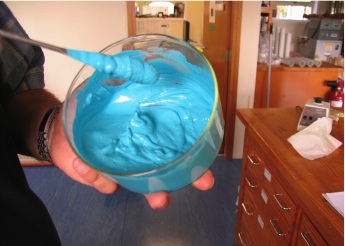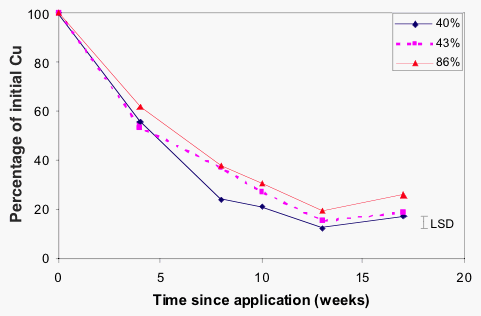PESTS AND DISEASES OF FORESTRY IN NEW ZEALAND
Improved and cheaper control of dothistroma needle blight
Scion is the leading provider of forest-related knowledge in New Zealand
Formerly known as the Forest Research Institute, Scion has been a leader in research relating to forest health for over 50 years. The Rotorua-based Crown Research Institute continues to provide science that will protect all forests from damage caused by insect pests, pathogens and weeds. The information presented below arises from these research activities.
From Forest Health News No. 175, July 2007.
The New Zealand forest industry spends around $2.5 million per year on Dothistroma control by aerial application of copper in a mixture of oil and water. There have been many advances in copper product formulation and spray technology over the past 15 years, offering an opportunity to improve application methods and efficacy, and to reduce application costs.
The success of copper application to control Dothistroma needle blight depends on:
- Ensuring efficient spray deposition on pine needles after release from the aircraft. Key factors are droplet size, evaporative properties of the spray, and meteorological conditions.
- Durability of the copper. After deposition the copper is exposed to rainfall, sunlight, and abrasion. The longer copper deposits remain on the leaf surface, the longer the protection provided.
In 2006, a research project was started to investigate methods for improving operational effectiveness of aerial spraying to control Dothistroma needle blight. The research was funded through the Dothistroma Control Committee, Forest Industry Development Agenda (FIDA), and the Forest Biosecurity Research Council (FBRC).
The project involved:
- reviewing copper and oil products on the market;
- characterising properties of the spray formulation, particularly in terms of viscosity, stability, and ability to spread after deposition on the pine needle surface;
- defining the potential for improving spray coverage through modifying the copper spray mix formulation and by reducing droplet size;
- testing the ability to lower costs by reducing the amount of formulation sprayed per hectare;
- determining the persistence of copper on the foliage over time using formulations developed in earlier stages of the project.

A total of six copper fungicide and eight spray oil combinations were tested for viscosity and stability at three different oil:water ratios. Some combinations of fungicide and oil could not be sprayed (Fig 1). Those combinations involved two fungicides, which were not considered in further work.
Cuprous oxide produced uniform suspensions with all of the test oils and, at reduced rates of active ingredient, copper hydroxide mixed well with the test oils and formed stable suspensions.
Copper oxychloride was very difficult to re-suspend, taking 6 to 8 times longer and requiring much more rigorous agitation than mixtures containing the other three fungicides.
Relative spread of droplets from one mineral oil and one Dothi- Spray oil was significantly larger than from the other six oils tested. This result was repeated with either cuprous oxide or copper oxychloride in the spray mixture. However, cuprous oxide consistently produced comparatively larger spread areas than copper oxychloride when mixed with the same oil. As the oil:water ratio increased from 40:60 to 50:50 and then to 100:0 the surface tension of the spray mixture reduced, and spread over the leaf surface increased. The oil content of the mixtures had much greater effect on droplet spread than the fungicide or oil used. It should be recognised that greater spread may not result in greater fungicidal efficacy because firstly, the copper may not be carried evenly in the droplet as it spreads, and secondly, distribution of copper over the entire needle surface may not necessarily improve control.
For the copper persistence tests, cuprous oxide was mixed with three spray oils (Dothi-Spray oil, mineral oil, and vegetable oil) and applied in formulations with three different oil concentrations (40%, 43%, and 86%), equating to two application volumes
(5l/ha and 3l/ha), giving a total of nine treatments. Each of the treatments was applied to 60 radiata pine seedlings under standard conditions in the Ensis track-spraying facility. For the 40% and 43% oil mixtures, the volume median diameter (VMD) of the applied droplet spectrum was approximately 65 microns. However, due to a higher viscosity the VMD of the 86% oil mixture was approximately 80 microns. The current aim is production of a 65 micron droplet.
After spraying, 10 randomly selected trees from each treatment were grouped and placed outside where they were exposed to natural weathering conditions. This procedure was repeated until six blocks of 90 trees were established. At 0, 4, 8, 10, 13, and 17 weeks after treatment individual blocks of 90 seedlings were randomly selected and harvested, and copper content was determined.
There was a rapid reduction in copper over the first 8 weeks, after which 25–40% of the initial dose remained on the plants. At the end of the experiment copper still persisted. This finding is promising compared with earlier work by Gilmour in which copperwas almost completely eroded after 3 months.

Copper persistence with all oils was similar, and the choice of oil for operational spraying should be dictated by other factors such as cost, handling properties, and environmental considerations.
This project has provided some important findings:
- Copper persistence and droplet spread can be maximised by increasing the concentration of oil in the spray mix.
- Copper persistence with high oil concentrations is improved by reducing total spray volumes from 5 l/ha to 3 l/ha.
- It may be feasible to reduce spray application rates to 3 l/ha by spraying with copper and oil alone.
- With the exception of two fungicides, there was little difference in performance of fungicides and oils.
These findings suggest that there is potential for reducing total spray volumes for Dothistroma control because, as water content is reduced and oil concentration increases, overall copper persistence and droplet spread increase. This is an important result because it suggests that reducing total spray volumes from 5 l/ha to 3 l/ha is worth evaluating in field studies. Such a reduction in total spray volumes would produce significant cost savings, and may result in increased efficacy.
Reports from these trials have been posted on the FBRC website (www.fbrc.org.nz).
Stefan Gous
This information is intended for general interest only. It is not intended to be a substitute for specific specialist advice on any matter and should not be relied on for that purpose. Scion will not be liable for any direct, indirect, incidental, special, consequential or exemplary damages, loss of profits, or any other intangible losses that result from using the information provided on this site.
(Scion is the trading name of the New Zealand Forest Research Institute Limited.)

 Farm Forestry New Zealand
Farm Forestry New Zealand

